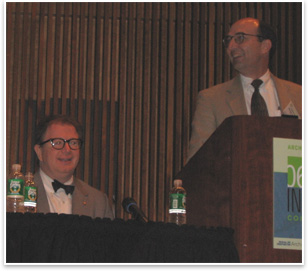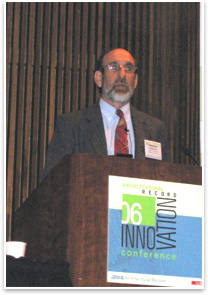Architectural Record Innovation
Conference Offers Lessons in Practical Aspects of Building Green
by Tracy Ostroff
Associate Editor
 Summary: The Architectural Record Innovation Conference, held in New York City October 12–13, brought together architects and engineers to discuss news, trends, and product developments affecting architecture and building systems today. The conference’s first day featured several practitioners sharing knowledge about the practical aspects of energy-efficient design, kicking off an intense program focusing on synthesis of design and technology. Summary: The Architectural Record Innovation Conference, held in New York City October 12–13, brought together architects and engineers to discuss news, trends, and product developments affecting architecture and building systems today. The conference’s first day featured several practitioners sharing knowledge about the practical aspects of energy-efficient design, kicking off an intense program focusing on synthesis of design and technology.
Test early, test often, test wisely (if budget
permits).
Nico Kienzl, a director at atelier ten, explained that there are many different ways to ascertain performance metrics through building modeling. “It’s just a question of expectations and how much information you need.” He highlighted several tools design teams can use to assess building performance. The first—and most comprehensive and costly—is whole-building modeling. That process starts with “elemental systems choices” and ideally should be done while “the design is still fluid” to see how different strategies would impact performance. The second was the thermal behavior model, which looks more specifically at design variables, such as comfort and performance metrics. The final type Kienzl highlighted was the daylight model, which, he lamented, is used more in architecture schools than in practice. He called it an inexpensive and amazing tool. “Architects have a sense of how light works in spaces; this explains the payback.”
You can get close to zero energy emissions.
Conference moderator and organizer Charles Linn, FAIA, challenged engineers from Arup to design a net-zero-energy building. Fiona Cousins and Gary Lawrence presented their response, an office building in Houston, where the region’s heat and humidity would put real-world constraints on the hypothetical mixed-use, purposefully energy-intensive 20-story building. They did not arrive at net zero energy, but found they could get quite close by parsing the design and each system for energy savings. “There is no silver bullet. You have to do a little bit of everything,” Cousins, a mechanical engineer, said. She noted that the building envelope and mechanical systems can work together to maximize efficiency.
 New products offer more design choices, opportunities
for customization. With gas prices still high and the ever-present
question of oil dependence on the lips of politicians, Solar Design
Associates President Steven J. Strong called this moment in time “the
perfect storm for renewables.” Strong has been in the photovoltaics
business since an epiphany working on the Alaskan Pipeline led
him to found his own firm in Cambridge, Mass. Through his practice,
he routinely works with architects to customize solar solutions
to capture energy and design intent. In the old days, he said,
it was perceived that to go solar meant ugly arrays; “not
the most discreet” part of design. When Strong started with
solar, the conversion efficiency rate was 7 percent. Now it’s
three times that and electric glass elements can be cut, colored,
and otherwise customized to the architect’s specifications.
He noted some of the many ways architects incorporate solar into
their projects: flat, tufted, or sloped roofs; solar sunshades;
and cantilevered canopies. New products offer more design choices, opportunities
for customization. With gas prices still high and the ever-present
question of oil dependence on the lips of politicians, Solar Design
Associates President Steven J. Strong called this moment in time “the
perfect storm for renewables.” Strong has been in the photovoltaics
business since an epiphany working on the Alaskan Pipeline led
him to found his own firm in Cambridge, Mass. Through his practice,
he routinely works with architects to customize solar solutions
to capture energy and design intent. In the old days, he said,
it was perceived that to go solar meant ugly arrays; “not
the most discreet” part of design. When Strong started with
solar, the conversion efficiency rate was 7 percent. Now it’s
three times that and electric glass elements can be cut, colored,
and otherwise customized to the architect’s specifications.
He noted some of the many ways architects incorporate solar into
their projects: flat, tufted, or sloped roofs; solar sunshades;
and cantilevered canopies.
True innovation requires the commitment of owners, tenants, and industry to follow through on energy conservation measures.
Bigger buildings mean super-sizing all energy consuming systems. Owners market “power allowances” to potential tenants, Cousins said, creating a building “bigger than it needs to be.” With that reality, designers either have to push for adaptive reuse projects or make the case for inserting energy-saving measures wherever they can. With end-use appliances increasingly more efficient, it behooves owners and tenants to carry through on the high-performance design intent with these products.
Expand the scope for renewable use and be smart about it.
If the architect cannot arrive at the desired target at the site itself, it may make sense to look to building neighbors or regional resources to achieve efficiency goals. For example, the building owners could cooperate with neighbors to share energy infrastructure and equipment, Cousins suggested. Ideally, the architect’s building would be a good citizen itself and return power to the grid.
Is getting to zero energy at the building level really the right idea?
Arup’s Gary Lawrence posed this question and the follow-up: “Or should we just do the best we can and do the rest through politics?” He suggested that the question is as much “political as it is technical.” A principal at the firm where is he an urban strategies leader, Lawrence challenged the architects in the room to help create real alternatives, noting that the government incentives are often a catalyst for change. “We have failed as designers to take leadership that gives people options.” The designers’ role is one of leadership in all sectors. “We have a moral obligation to move beyond conventional wisdom to challenge our clients.”
|


 Summary:
Summary: New products offer more design choices, opportunities
for customization.
New products offer more design choices, opportunities
for customization.